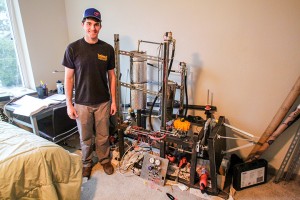
Kevin Freeman | Lariat Photographer
By Viola Zhou
Reporter
San Antonio junior Kevin Healy has always enjoyed building. In high school, he built an electric car. Nowadays, he’s extending his passion to rockets.
Healy, a mechanical engineering major, is the leader of the Horizon Rocket Project, which aims to build a low-cost but powerful rocket to assist scientific research. Healy started building the rocket in August and plans on finishing the engine by next month.
Healy said his interest motivated him to initiate the project.
“Primarily it’s because it’s fun,” Healy said. “I’m excited about rocketry and excited about going to space.”
Healy said another purpose of this project is to allow researchers to do experiments in space by designing a cheaper rocket model.
“Now researchers have to go through either NASA or SpaceX,” he said. “That’s kind of expensive and you have to do it on their schedule. A vehicle like this would make it easier for smaller experiments to get into space. It will allow smaller institutions like Baylor and other universities to be able to do something in space.”
Healy said most amateurs use solid fuel for their rockets, but his rocket will be powered by liquid fuel, allowing it to reach a higher altitude.
He said although liquid-fuel rockets are more complicated and time-consuming to build, he wants to give it a try.
Without access to a laboratory, Healy did most of the building in his apartment near Baylor campus. He said some parts of the installation have a risk of explosion.
“It is dangerous,” he said. “You can have a burn-out of the engine, which could cause explosion. You have liquid oxygen tank, which can explode because it’s under high pressure. There are a lot of things that can go wrong. And if they do, it will explode.”
He said the project was supported by his chemistry teacher Dr. Vanessa Castleberry and an engineer at space transport services company SpaceX.
Castleberry, a lecturer of chemistry, said she helps Healy to contact people in the industry to get material supply and solve technical problems. She joined the project because she saw Healy’s persistence and intelligence.
“He is a fun person to be working with,” Castleberry said. “He is very inspiring. I wish I was as smart as he was. Mentally, I enjoy the process.”
She said she expects difficulty in getting the rocket fuel they need, as people will raise their eyebrows if an individual wants order small amounts of chemicals.
Castleberry said she has no doubts Healy’s rocket dream will come true.
“Kevin is unflappable and determined,” she said. “Kevin never gets thrown off by setbacks and he learns from failures. That’s a very rare characteristic of individual.”
Healy said his rocket will reach an altitude higher than 72 miles, the record for amateur rockets. Outer space begins at 62 miles above sea level.
“I can more accurately pick a number for altitude after I get money to build the actually vehicle, because I’ll be able to see what I can afford,” he said. “Just more money makes it higher.”
Healy said the whole project will cost $25,000, and the $7,000 he has raised is running out. He is spreading words about what he is doing through the project’s website and Facebook page.
“Fund-raising is the hardest part of this project,” he said. “The building is easy.”
Healy said he set the launch date in December when he started the project, but the process is taking longer than planned.
“It turns out building a rocket is a lot harder than I thought,” he said. “I have never done anything like this. Hopefully it works.”





